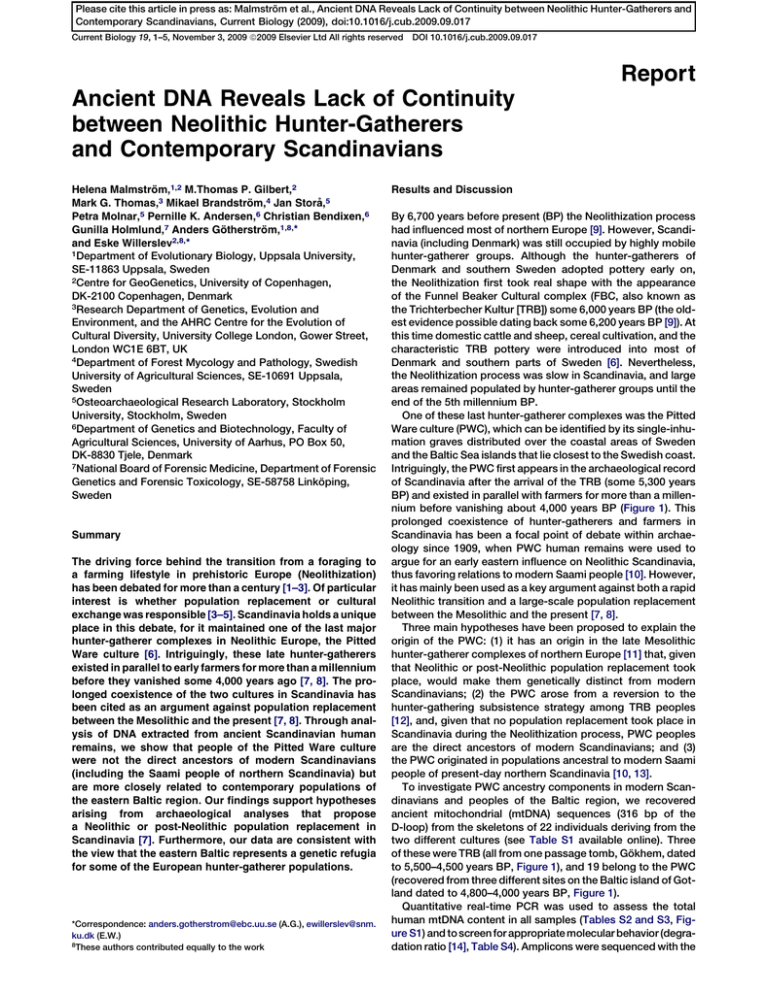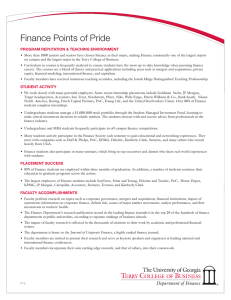
Please cite this article in press as: Malmström et al., Ancient DNA Reveals Lack of Continuity between Neolithic Hunter-Gatherers and
Contemporary Scandinavians, Current Biology (2009), doi:10.1016/j.cub.2009.09.017
Current Biology 19, 1–5, November 3, 2009 ª2009 Elsevier Ltd All rights reserved
DOI 10.1016/j.cub.2009.09.017
Report
Ancient DNA Reveals Lack of Continuity
between Neolithic Hunter-Gatherers
and Contemporary Scandinavians
Helena Malmström,1,2 M.Thomas P. Gilbert,2
Mark G. Thomas,3 Mikael Brandström,4 Jan Storå,5
Petra Molnar,5 Pernille K. Andersen,6 Christian Bendixen,6
Gunilla Holmlund,7 Anders Götherström,1,8,*
and Eske Willerslev2,8,*
1Department of Evolutionary Biology, Uppsala University,
SE-11863 Uppsala, Sweden
2Centre for GeoGenetics, University of Copenhagen,
DK-2100 Copenhagen, Denmark
3Research Department of Genetics, Evolution and
Environment, and the AHRC Centre for the Evolution of
Cultural Diversity, University College London, Gower Street,
London WC1E 6BT, UK
4Department of Forest Mycology and Pathology, Swedish
University of Agricultural Sciences, SE-10691 Uppsala,
Sweden
5Osteoarchaeological Research Laboratory, Stockholm
University, Stockholm, Sweden
6Department of Genetics and Biotechnology, Faculty of
Agricultural Sciences, University of Aarhus, PO Box 50,
DK-8830 Tjele, Denmark
7National Board of Forensic Medicine, Department of Forensic
Genetics and Forensic Toxicology, SE-58758 Linköping,
Sweden
Summary
The driving force behind the transition from a foraging to
a farming lifestyle in prehistoric Europe (Neolithization)
has been debated for more than a century [1–3]. Of particular
interest is whether population replacement or cultural
exchange was responsible [3–5]. Scandinavia holds a unique
place in this debate, for it maintained one of the last major
hunter-gatherer complexes in Neolithic Europe, the Pitted
Ware culture [6]. Intriguingly, these late hunter-gatherers
existed in parallel to early farmers for more than a millennium
before they vanished some 4,000 years ago [7, 8]. The prolonged coexistence of the two cultures in Scandinavia has
been cited as an argument against population replacement
between the Mesolithic and the present [7, 8]. Through analysis of DNA extracted from ancient Scandinavian human
remains, we show that people of the Pitted Ware culture
were not the direct ancestors of modern Scandinavians
(including the Saami people of northern Scandinavia) but
are more closely related to contemporary populations of
the eastern Baltic region. Our findings support hypotheses
arising from archaeological analyses that propose
a Neolithic or post-Neolithic population replacement in
Scandinavia [7]. Furthermore, our data are consistent with
the view that the eastern Baltic represents a genetic refugia
for some of the European hunter-gatherer populations.
*Correspondence: anders.gotherstrom@ebc.uu.se (A.G.), ewillerslev@snm.
ku.dk (E.W.)
8These authors contributed equally to the work
Results and Discussion
By 6,700 years before present (BP) the Neolithization process
had influenced most of northern Europe [9]. However, Scandinavia (including Denmark) was still occupied by highly mobile
hunter-gatherer groups. Although the hunter-gatherers of
Denmark and southern Sweden adopted pottery early on,
the Neolithization first took real shape with the appearance
of the Funnel Beaker Cultural complex (FBC, also known as
the Trichterbecher Kultur [TRB]) some 6,000 years BP (the oldest evidence possible dating back some 6,200 years BP [9]). At
this time domestic cattle and sheep, cereal cultivation, and the
characteristic TRB pottery were introduced into most of
Denmark and southern parts of Sweden [6]. Nevertheless,
the Neolithization process was slow in Scandinavia, and large
areas remained populated by hunter-gatherer groups until the
end of the 5th millennium BP.
One of these last hunter-gatherer complexes was the Pitted
Ware culture (PWC), which can be identified by its single-inhumation graves distributed over the coastal areas of Sweden
and the Baltic Sea islands that lie closest to the Swedish coast.
Intriguingly, the PWC first appears in the archaeological record
of Scandinavia after the arrival of the TRB (some 5,300 years
BP) and existed in parallel with farmers for more than a millennium before vanishing about 4,000 years BP (Figure 1). This
prolonged coexistence of hunter-gatherers and farmers in
Scandinavia has been a focal point of debate within archaeology since 1909, when PWC human remains were used to
argue for an early eastern influence on Neolithic Scandinavia,
thus favoring relations to modern Saami people [10]. However,
it has mainly been used as a key argument against both a rapid
Neolithic transition and a large-scale population replacement
between the Mesolithic and the present [7, 8].
Three main hypotheses have been proposed to explain the
origin of the PWC: (1) it has an origin in the late Mesolithic
hunter-gatherer complexes of northern Europe [11] that, given
that Neolithic or post-Neolithic population replacement took
place, would make them genetically distinct from modern
Scandinavians; (2) the PWC arose from a reversion to the
hunter-gathering subsistence strategy among TRB peoples
[12], and, given that no population replacement took place in
Scandinavia during the Neolithization process, PWC peoples
are the direct ancestors of modern Scandinavians; and (3)
the PWC originated in populations ancestral to modern Saami
people of present-day northern Scandinavia [10, 13].
To investigate PWC ancestry components in modern Scandinavians and peoples of the Baltic region, we recovered
ancient mitochondrial (mtDNA) sequences (316 bp of the
D-loop) from the skeletons of 22 individuals deriving from the
two different cultures (see Table S1 available online). Three
of these were TRB (all from one passage tomb, Gökhem, dated
to 5,500–4,500 years BP, Figure 1), and 19 belong to the PWC
(recovered from three different sites on the Baltic island of Gotland dated to 4,800–4,000 years BP, Figure 1).
Quantitative real-time PCR was used to assess the total
human mtDNA content in all samples (Tables S2 and S3, Figure S1) and to screen for appropriate molecular behavior (degradation ratio [14], Table S4). Amplicons were sequenced with the
Please cite this article in press as: Malmström et al., Ancient DNA Reveals Lack of Continuity between Neolithic Hunter-Gatherers and
Contemporary Scandinavians, Current Biology (2009), doi:10.1016/j.cub.2009.09.017
Current Biology Vol 19 No 20
2
Figure 1. Scandinavia with the PWC and the Architectural Structures of the
TRB Displayed
The three TRB sequences originate from Gökhem, Sweden, and the 19 PWC
sequences originate from sites on Gotland, Sweden.
Roche Genome Sequencer FLX platform to retrieve synthetic
clones [15] (Table S5). Sequences were regarded as authentic
if they (1) originated from DNA extracts containing more than
1000 molecules of the quantified 80 bp fragment, (2) were supported by two independent extractions, (3) were based on
a minimum of 20 synthetic FLX clone sequences, and (4) expressed a degradation ratio higher than 1 (Supplemental Data).
Reduced median networks [16] were used to graphically
illustrate substitution differences among sequences and to
enable sequence assignation to previously defined haplogroups [4, 17]. Haplogroups U4/H1b, U5, and U5a were
found to have high incidence among the PWC but are all rare
among contemporary Scandinavians and Saami (Figures 2A–
2C). It is noteworthy that a high frequency of U lineages, especially U5, has been inferred for pre-Neolithic Europeans with
the use of modern mtDNA data [18]. Interestingly, compared
to the rest of Europe, the U haplogroups have relatively high
frequencies among populations in the eastern Baltic region
such as the Latvians and the Lithuanians (Figure 2C).
Analysis of molecular variance [19] (AMOVA) revealed that
the PWC sequences are significantly differentiated from samples of contemporary Swedes [20] (n = 289, FST = 0.05174,
p < 0.001), Saami [20] (n = 38, FST = 0.25037, p < 1026), Norwegians [21] (n = 323, FST = 0.06148, p < 0.001), Finns [22] (n = 79,
FST = 0.05327, p < 0.005), Estonians [22] (n = 117, FST = 0.04745,
p < 0.003), Lithuanians [22] (n = 163, FST = 0.04022, p < 0.004),
and Latvians [22] (n = 114, FST = 0.03622, p < 0.011). To
examine whether population differences could be accounted
for by drift alone under the null hypothesis of population continuity, we performed coalescent simulations assuming a wide
range of combinations of ancestral population size at the
Upper Paleolithic colonization of Europe, 45,000 years ago,
and the time of arrival of farming in Scandinavia, 6,200 years
ago. As a conservative measure, we assumed a relatively
high (compared to other published estimates) mutation rate
of 7.5 3 1026 per site per generation [23] to ease the burden
of explaining high FST values. We sampled sequences from
each simulation according to the numbers and dates of the
data considered here and calculated the proportion of simulated FST values that were greater than those observed
(Supplemental Data).
The null hypothesis of population continuity between the PWC
and modern Swedes can be rejected under a range of assumed
ancestral population size combinations (including almost all that
assume a Neolithic effective population size > 15,000), as can
population continuity between the PWC and Norwegians under
most assumed ancestral population size combinations (including almost all that assume a Neolithic effective population
size > 6,000) (Figure 3). Population continuity between the
PWC and modern Saami can be rejected under all assumed
ancestral population size combinations. However, population
continuity between the PWC and contemporary Baltic populations cannot be rejected under most assumed ancestral population size combinations (Supplemental Data).
These results indicate that the PWC hunter-gatherers
are unlikely to be the main ancestors of either modern Scandinavians or Saami, despite their presence in Scandinavia at the
early stages of Neolithization. On the contrary, the observed
FST values indicate greater similarity between the PWC and
modern eastern Baltic populations, and coalescent simulations confirm that those non-Scandinavian populations could
plausibly be the direct descendents of PWC hunter-gatherers.
Having only obtained three TRB sequences, we cannot
exclude continuity with any of the modern populations.
Although complex demographic scenarios such as local
population structuring, or sampling problems including close
relatedness among individuals from the same site, might also
explain the patterns of differentiation that we observe, we
found no significant differentiation among the three PWC sites
that we sampled (AMOVA pairwise FST = 20.0189; p = 0.54733;
exact test of population differentiation global p value =
0.43421) and also note that the ubiquity of U4 and U5 types
at those sites suggests that we are looking at patterns of
genetic variation that extend beyond the local scale. It is noteworthy, however, that our interpretation is highly dependent on
the assumed effective population size (Ne) at the onset of the
Neolithic in Scandinavia 6,200 years BP. If Ne at this time
were low (< 6,000 if modern Norwegians and Swedes share
a common ancestry, < 15,000 for the unlikely event that the
two populations have different ancestry in the region), then drift
would be sufficient to explain the FSTs for both modern Swedes
and northeastern Baltic peoples. Furthermore, it may be
possible that a relatively low level of admixture in Scandinavia
between the PWC and the TRB could be sufficient to explain
the differences observed between the PWC and modern
Scandinavians. Currently, however, this remains untestable,
because we lack an appropriate proxy for early farmers.
Given our results, it remains possible that the PWC represent
remnants of a larger northern European Mesolithic huntergather complex. However, it appears unlikely that population
continuity exists between the PWC and contemporary Scandinavians or Saami. Thus, our findings are in agreement with
archaeological theories suggesting Neolithic or post-Neolithic
population introgression or replacement in Scandinavia. To
what extent this holds true for other parts of Europe requires
further direct testing, although morphological [24, 25], ancient
Please cite this article in press as: Malmström et al., Ancient DNA Reveals Lack of Continuity between Neolithic Hunter-Gatherers and
Contemporary Scandinavians, Current Biology (2009), doi:10.1016/j.cub.2009.09.017
Hunter-Gatherers Reveals Lack of Continuity
3
A
C
Hg
Sam
Est
Lit
Lat
PWC
TRB
0.003
0
0
0
0
0
0
C
0.003
0
0
0
0
0
0
D4/G
0.007
0
0
0
0.009
0
0
H
0.286
0
0.179
0.172
0.105
0
0.333
H1
0.038
0
0.026
0.123
0.061
0
0
H1a
0.028
0
0.051
0.037
0.018
0
0
H1f
0.003
0
0
0
0
0
0
H2
0.003
0
0
0
0.009
0
0
H2a1
0.010
0
0.026
0.012
0.018
0
0
H3
0.003
0
0.009
0.006
0.018
0
0
H5
0.031
0
0.017
0.031
0.079
0
0
H6
0.031
0
0.060
0.031
0
0
0
I
0.024
0
0
0
0
0
0
I1
0.003
0
0.017
0.025
0.053
0
0
J
0.091
0
0.085
0.037
0.044
0.053
0.333
J1a
B
Swe
B
0
0
0.009
0
0.009
0
0
J1b1
0.003
0
0.034
0.012
0
0
0
K
0.070
0
0.009
0.006
0.026
0
0
other
0.031
0.051
0.034
0.092
0.018
0.106
0
T
0.059
0
0.111
0.067
0.070
0.053
0.333
T1
0.017
0
0.026
0.037
0.018
0
0
U
0.021
0
0.009
0.018
0.035
0
0
U2
0.014
0
0.026
0
0.053
0
0
U3
0
0
0.009
0.006
0.035
0
0
0.056
0
0.085
0.080
0.132
0.421
0
U4/H1b
U5
U5a
0
0
0
0
0.009
0.158
0
0.014
0
0.026
0.055
0.044
0.158
0
U5a1
0.035
0
0.068
0.037
0.053
0
0
U5b
0.024
0
0.026
0.025
0.026
0
0
U5b1b
0.014
0.308
0.009
0
0
0
0
V
0.035
0.641
0.017
0.061
0.018
0.053
0
W
0.014
0
0.026
0.031
0.044
0
0
X
0.024
0
0.009
0
0
0
n
290
37
117
163
114
19
0
3
Figure 2. Haplogroup Distributions in Investigated Populations
Reduced-median networks were constructed with 1 as threshold.
(A) PWC (red) shares five haplotypes (Hts) with the 323 Norwegian sequences (white) and keeps five private.
(B) PWC (red) shares four Hts with the 290 Swedish sequences (black) and keeps six private.
(C) The most common Hgs in the PWC sample are rare in the Swedish sample, whereas the frequency is somewhat elevated in the samples from the Baltic
peoples.
The following abbreviations are used: Hg, haplogroup; Swe, Swedes; Sam, Saami; Est, Estonians; Lit, Lithuanians; Lat, Latvians; PWC, Pitted Ware culture;
and TRB, Funnel Beaker culture.
[26], and modern [4, 5] genetic data suggest that this is probably the case. Thus, theories favoring a Neolithization process
that involved population continuity and was mediated by
culture exchange only appear increasingly unlikely. Interestingly, however, the data analyses are consistent with a view
that the eastern Baltic area remained a genetic refugia for
some of the European hunter-gatherer populations. This is in
agreement with findings of Mesolithic to Neolithic continuity
among Latvian cemeteries [27]. Although the hunter-gatherer
lifestyle was culturally replaced here, as in Scandinavia, the
populations of the eastern Baltic area may have kept a certain
level of population continuity.
Experimental Procedures
Skeletal remains from 74 individuals of eight middle-Neolithic sites were
initially selected. Of these, 41 yielded sequence data, but only 22 (19 PWC
and 3 TRB) met all requirements demanded for authenticity (Supplemental
Data). A set of nonhuman samples, mainly harp seals (Phoca groenlandica,
n = 31), of the same age and from the same sites as the human remains were
used as controls and screened for human DNA (contamination) as well as for
putative animal DNA (preservation). The material was extracted in duplicates via a silica spin-column method including chemical decontamination
[14] (Supplemental Data).
Quantitative real-time PCR of an 80 bp and a 136 bp coding-region fragment
was used to assess the total human mtDNA content in all samples and to
screen for appropriate molecular behavior (degradation [14]) (Supplemental
Data, Table S1). We amplified the D-loop in seven overlapping fragments of
varying size and sequenced them on the Roche Genome Sequencer FLX
System to retrieve synthetic clones. Tagged primers were used to provide
for individual identification after sequencing [15] (Supplemental Data).
For analyses, we used 316 bp of the D-loop, spanning 16,051–16,383 (16
positions were removed, Supplemental Data). Analysis of molecular variance and Fst calculations was carried out with the Arlequin 3.1 software
[19]. Networks were constructed with the NETWORK software and the
reduced median algorithm [16], with the threshold set for 1. Coalescent
Please cite this article in press as: Malmström et al., Ancient DNA Reveals Lack of Continuity between Neolithic Hunter-Gatherers and
Contemporary Scandinavians, Current Biology (2009), doi:10.1016/j.cub.2009.09.017
Current Biology Vol 19 No 20
4
4450
8400
12350
16300
20250
Ne at onset of LBK 6,200 BP
C
998
1986
2974
3962
4950
PWC v Swedes (FST = 0.05174)
10
3962
2974
1986
998
500
500
4450
8400
12350
16300
Ne at onset of LBK 6,200 BP
20250
Figure 3. Probabilities of Obtaining the Observed
Genetic Differences, as Measured by FST,
between Ancient PWC and Modern Population
Samples under a Model of Population Continuity
Population sample comparisons are (A) PWC
hunter-gatherers versus modern Norwegians, (B)
PWC hunter-gatherers versus modern Swedes,
and (C) PWC hunter-gatherers versus modern
Saami. Probabilities were calculated by comparing observed FST values to those obtained by coalescent simulation across a range of combinations
of ancestral effective female population sizes at
the start of farming in Scandinavia 6,200 years
ago (x axis) and the initial colonization of Europe
45,000 years ago (y axis). Observed FST values
are indicated, and black shaded areas indicate
p values > 0.05.
4950
0.05
3962
0.04
2974
0.03 Probability of obtaining
1986
0.02 than that observed
998
PWC v Saami (FST = 0.25037)
0.01
FST value greater
Black shaded regions
represents p > 0.05
10
Ne at colonization of Europe 45,000 BP
B
Ne at colonization of Europe 45,000 BP
4950
PWC v Norwegians (FST = 0.06148)
10
Ne at colonization of Europe 45,000 BP
A
0.00
500
4450
8400
12350
16300
20250
Ne at onset of LBK 6,200 BP
simulations were performed assuming a wide range of combinations of
ancestral population size at the Upper Palaeolithic colonization of Europe,
45,000 years ago (Ne = 10–4,959, and time of arrival of farming in Scandinavia 6,200 years ago, Ne = 500–20,350). Sequences were sampled from each
simulation according to the numbers and dates of the data considered, and
the proportion of simulated FST values that were greater than those
observed were calculated (details on the evolutionary models are provided
in Supplemental Data).
Supplemental Data
Supplemental Data include Supplemental Experimental Procedures, five
tables, and four figures and can be found with this article online at http://
www.cell.com/current-biology/supplemental/S0960-9822(09)01694-7.
Acknowledgments
We thank Lotta Tomasson for graphic designs; Love Dalén and Jonas Binladen for valuable discussions; Ulla Palm, Helena Nilsson, Andreas Tillmar, and
Monica Lindman for technical assistance; and the Swedish National Laboratory of Forensic Science (SKL) for letting us use their ABI Prism 3700. Material
was kindly provided by Per Persson, Leena Drenzel, Karl-Göran Sjögren, and
Marietta Douglas, and Jonathan Lindström assisted in estimating the true
population size in Neolithic Scandinavia. This work was supported by Marie
Curie Actions (FP6-MEIF-CT-2005-025002 ‘‘FORMAPLEX’’) and Danish
Natural Science Research Council (‘‘Skou’’ grants) (to M.T.P.G.); Marie Curie
Actions (MEST-CT-2004-7909 ‘‘GENETIME’’ grant to E.W. and H.M.); the
Danish National Research Foundation (E.W. and M.T.P.); the Swedish
Research Council (A.G. and H.M.); the Board for Research and Development,
National Board of Forensic Medicine grant 4155216 (to G.H.); the Royal
Swedish Academy of Science (to A.G.); and the Arts and Humanities
Research Council Centre for the Evolution of Cultural Diversity (M.G.T.).
Received: July 30, 2009
Revised: September 1, 2009
Accepted: September 8, 2009
Published online: September 24, 2009
References
1. Armelagos, G.J., and Harper, K.N. (2005). Genomics at the origins of
agriculture: Part II. Evol. Anthropol. 14, 109–121.
2. Sampietro, M.L., Lao, O., Caramelli, D., Lari, M., Pou, R., Martı́, M.,
Bertranpetit, J., and Lalueza-Fox, C. (2007). Palaeogenetic evidence
supports a dual model of Neolithic spreading into Europe. Proc. Biol.
Sci. 274, 2161–2167.
3. Zvelebil, M. (2004). In Traces of Ancestry: Studies in Honour of Colin
Renfrew, M. Jones, ed. (Cambridge: McDonald Institute Monographs).
4. Richards, M.B., Macaulay, V.A., Bandelt, H.J., and Sykes, B.C. (1998).
Phylogeography of mitochondrial DNA in western Europe. Ann. Hum.
Genet. 62, 241–260.
5. Semino, O., Passarino, G., Oefner, P.J., Lin, A.A., Arbuzova, S., Beckman,
L.E., De Benedictis, G., Francalacci, P., Kouvatsi, A., Limborska, S., et al.
(2000). The genetic legacy of paleolithic Homo sapiens sapiens in extant
europeans: A Y chromosome perspective. Science 290, 1155–1159.
6. Stenbäck, N. (2003). Människorna vid havet. Platser och keramik på
ålandsöarna perioden 3500–2000 f.Kr. PhD thesis, Stockholm University. In Stockholm Studies in Archaeology, Volume 28 (Stockholm:
Stockholm University).
7. Richards, M.P., Schulting, R.J., and Hedges, R.E. (2003). Sharp shift in
diet at onset of Neolithic. Nature 425, 366.
8. Lidén, K., Eriksson, G., Nordqvist, B., Götherström, A., and Bendixen, E.
(2004). ‘‘The wet and the wild followed by the dry and the tame’’ – or did
they occur at the same time? Diet in Mesolithic - Neolithic southern
Sweden. Antiquity 78, 23–33.
9. Fischer, A. (2002). Food for Feasting? An evaluation of explanations
of the neolithisation of Denmark and southern Sweden. In The Neolithisation of Denmark – 150 Years of Debate. Sheffield Archaeological
Monographs 12, A. Fischer and K. Kristensen, eds. (Sheffield: J.R. Collis
Publications).
10. Kossinna, G. (1909). Der Ursprung der Urfinnen und der Urindogermanen und ihre Ausbreitung nach dem Osten. Mannus 1, 17–52 and 225–
245.
Please cite this article in press as: Malmström et al., Ancient DNA Reveals Lack of Continuity between Neolithic Hunter-Gatherers and
Contemporary Scandinavians, Current Biology (2009), doi:10.1016/j.cub.2009.09.017
Hunter-Gatherers Reveals Lack of Continuity
5
11. Malmer, M.P. (1969). Gropkeramiksplatsen Jonstorp. Antikvariskt Arkiv,
Volume 36 (Stockholm: Kungl. Vitterhets Historie och Antikvitets Akademien).
12. Browall, H. (1991). In Västsvenska Stenåldersstudier, Volume 8,
H. Browall, P. Persson, and K.G. Sjögren, eds. (Göteborg: GOTARC),
pp. 111–142.
13. Almgren, O. (1907). Nordiska stenåldersskulpturer. Fornvännen 2,
113–125.
14. Malmström, H., Svensson, E.M., Gilbert, M.T., Willerslev, E., Götherström, A., and Holmlund, G. (2007). More on contamination: The use
of asymmetric molecular behavior to identify authentic ancient human
DNA. Mol. Biol. Evol. 24, 998–1004.
15. Binladen, J., Gilbert, M.T., Bollback, J.P., Panitz, F., Bendixen, C.,
Nielsen, R., and Willerslev, E. (2007). The use of coded PCR primers
enables high-throughput sequencing of multiple homolog amplification
products by 454 parallel sequencing. PLoS ONE 2, e197.
16. Bandelt, H.J., Forster, P.B., Sykes, C., and Richards, M.B. (1995).
Mitochondrial portraits of human populations. Genetics 141, 743–753.
17. Kivisild, T., Tolk, H.V., Parik, J., Wang, Y., Papiha, S.S., Bandelt, H.J.,
and Villems, R. (2002). The emerging limbs and twigs of the East Asian
mtDNA tree. Mol. Biol. Evol. 19, 1737–1751.
18. Richards, M., Macaulay, V., Hickey, E., Vega, E., Sykes, B., Guida, V.,
Rengo, C., Sellitto, D., Cruciani, F., Kivisild, T., et al. (2000). Tracing
European founder lineages in the Near Eastern mtDNA pool. Am. J.
Hum. Genet. 67, 1251–1276.
19. Excoffier, L., Laval, G., and Schneider, S. (2005). Arlequin (version 3.0):
An integrated software package for population genetics data analysis.
Evol. Bioinform. Online 1, 47–50.
20. Tillmar, A.O., Coble, M.D., Wallerström, T., and Holmlund, G. (2009).
Homogeneity in mitochondrial DNA control region sequences in
Swedish subpopulations. Int. J. Leg. Med., in press. Published online
July 10 2009. 10.1007/s00414-009-0354-7.
21. Helgason, A., Hickey, E., Goodacre, S., Bosnes, V., Stefánsson, K.,
Ward, R., and Sykes, B. (2001). mtDNA and the islands of the North
Atlantic: Estimating the proportions of Norse and Gaelic ancestry. Am.
J. Hum. Genet. 68, 723–737.
22. Lappalainen, T., Laitinen, V., Salmela, E., Andersen, P., Huoponen, K.,
Savontaus, M.L., and Lahermo, P. (2008). Migration waves to the Baltic
Sea region. Ann. Hum. Genet. 72, 337–348.
23. Ho, S.Y., and Endicott, P. (2008). The crucial role of calibration in molecular date estimates for the peopling of the Americas. Am. J. Hum. Genet.
83, 142–146.
24. Brace, C.L., Nelson, A.R., Seguchi, N., Oe, H., Sering, L., Qifeng, P.,
Yongyi, L., and Tumen, D. (2001). Old World sources of the first New
World human inhabitants: A comparative craniofacial view. Proc. Natl.
Acad. Sci. USA 98, 10017–10022.
25. Brace, C.L., Seguchi, N., Quintyn, C.B., Fox, S.C., Nelson, A.R., Manolis,
S.K., and Qifeng, P. (2006). The questionable contribution of the
Neolithic and the Bronze Age to European craniofacial form. Proc.
Natl. Acad. Sci. USA 103, 242–247.
26. Haak, W., Forster, P., Bramanti, B., Matsumura, S., Brandt, G., Tänzer,
M., Villems, R., Renfrew, C., Gronenborn, D., Alt, K.W., and Burger, J.
(2005). Ancient DNA from the first European farmers in 7500-year-old
Neolithic sites. Science 310, 1016–1018.
27. Larsson, L., and Zagorska, I. (2006). Back to the origin: research in the
Mesolithic-Neolithic Zvejnieki cemetery and environment, northern
Latvia. Acta Archaeologica Lundensia, Volume 52 (Stockholm: Almqvist
& Wiksell International).









